Etude de bruit de fond induit par les muons dans l'expérience ...
Etude de bruit de fond induit par les muons dans l'expérience ...
Etude de bruit de fond induit par les muons dans l'expérience ...
You also want an ePaper? Increase the reach of your titles
YUMPU automatically turns print PDFs into web optimized ePapers that Google loves.
tel-00724955, version 1 - 23 Aug 2012<br />
C<br />
152 Definition of the bolometer timing<br />
and<br />
C.3 An example for Run 8<br />
t 0 H + ∆tH · 0.5 + T C<br />
= t max<br />
H − ∆tH · fH + ∆tH · 0.5 + t p<br />
H − tmax H<br />
= t p<br />
H<br />
(C.4)<br />
The event chosen as example for Run 8 is the 3 rd event of the run of Jan 2 th 2008,<br />
which correspond to runntp = ia02a005, and runANA = 120205.<br />
From the data analysis file, we have the time difference of the beginning of the<br />
run and of the beginning of the ionization interval, which is for Run 8 the time of<br />
the beginning of the ionization interval:<br />
T H = t 0 I = 15019.483 ms (C.5)<br />
T H is already corrected by the factor 1.008. We also have the time of the beginning<br />
of the ionization pulse relative to the center of the ionization interval:<br />
T I = 0.68573 · 1.008 ms (C.6)<br />
From the data acquisition, i.e. the ntp file, which contain the same information<br />
than the corresponding raw data fi<strong>les</strong>, we have the time of the maximum of the<br />
filtered heat pulse:<br />
t max<br />
H<br />
Thus, it is clear that T H and t max<br />
H<br />
= 1493100 unit of the 10 µs clock<br />
= 14931.000 · 1.008 ms<br />
= 15050.448 ms (C.7)<br />
are different and have a different signification,<br />
<strong>de</strong>spite a misleading name in the bolometer analysis ANA. T H is the beginning of<br />
the ionization interval and tmax H is the maximum of the heat pulse.<br />
The time of the maximum of the heat pulse in ANA can be evaluated if we add<br />
the pre-trigger fI = 0.75 of the sample window to the time of the beginning of the<br />
ionization window:<br />
max<br />
tH ANA = t0I + ∆tI · fI · 1.008 (C.8)<br />
= T H + ∆tI · fI · 1.008<br />
= 15019.483 ms + 40.96 · 0.75 · 1.008 ms<br />
Com<strong>par</strong>ing Equations C.7 and C.9, we have tmax <br />
H<br />
= 15050.449 ms (C.9)<br />
ANA<br />
= tmax H , we find back the ntp<br />
time stamp from the time of the analysis. We are now certain that the time used in<br />
the analysis and the time used in the ntp is the same and is the one coming from the<br />
<strong>de</strong>vice which dispatch the clock in 10 µs-beat, and not some arrangements from tPC. ∗<br />
∗ About tPC, the real time read in the ntp file is tPC = 1199263394.124085, then tPC − t0 PC =<br />
1199263394.124085 − 1199263379.193085 = 14931.000 ms. Therefore tPC − t0 PC = tmax H · 10−5 still<br />
holds as it is <strong>de</strong>fined in Table C.1.


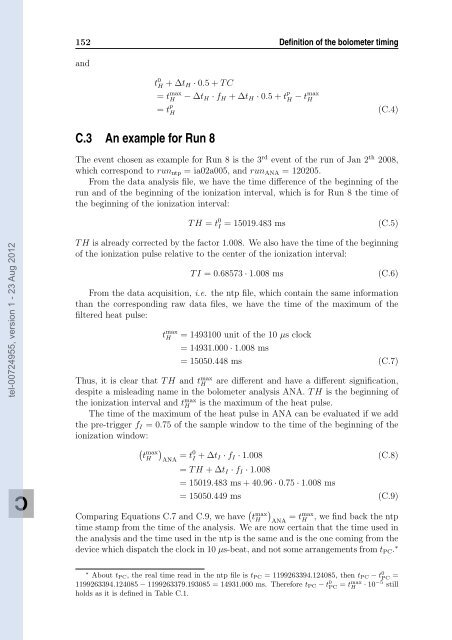

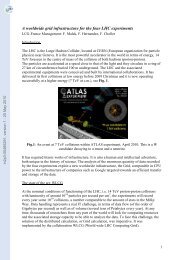

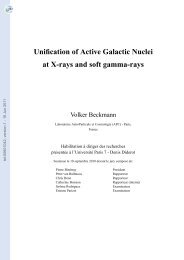

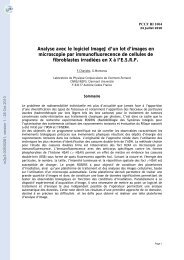
![[in2p3-00383985, v1] NUCLEAR PHYSICS at GANIL ... - HAL - IN2P3](https://img.yumpu.com/19016755/1/185x260/in2p3-00383985-v1-nuclear-physics-at-ganil-hal-in2p3.jpg?quality=85)
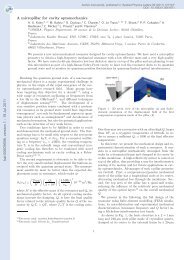
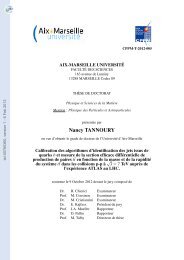
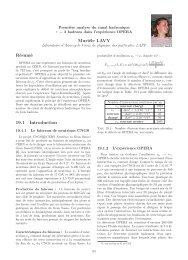
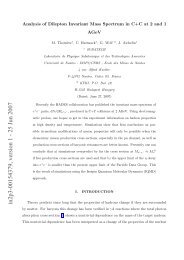
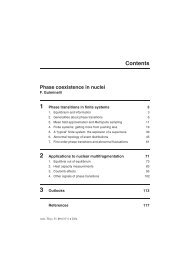
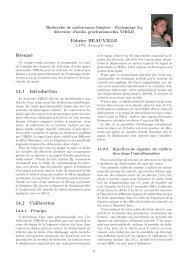
![[tel-00752304, v1] Pions réels et virtuels dans les noyaux](https://img.yumpu.com/19016523/1/184x260/tel-00752304-v1-pions-reels-et-virtuels-dans-les-noyaux.jpg?quality=85)